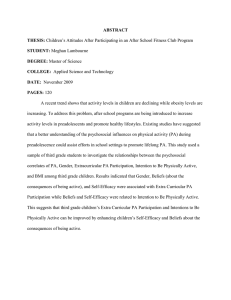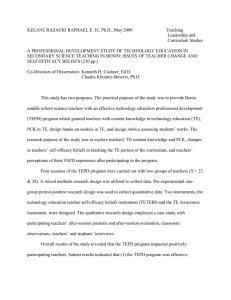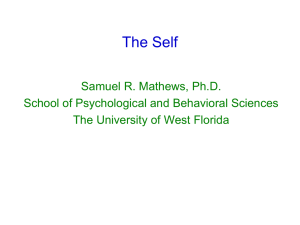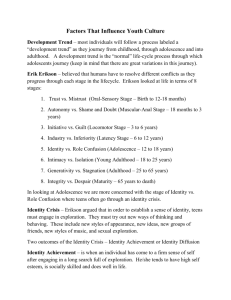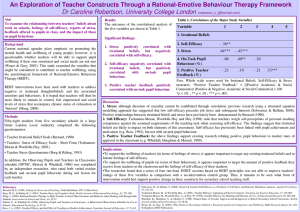identity Lecture
advertisement
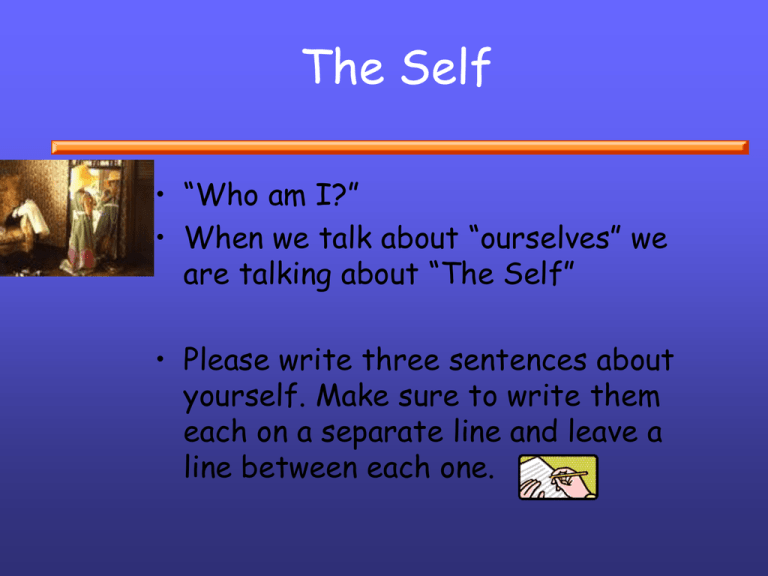
The Self • “Who am I?” • When we talk about “ourselves” we are talking about “The Self” • Please write three sentences about yourself. Make sure to write them each on a separate line and leave a line between each one. Self Concept & Self Esteem • Self-Concept – The subset of a person’s stored knowledge, which concerns himself or herself as a distinctive object in the world. (Higgins & May, 2001) • Self Esteem – Feelings that people have about their own capabilities and selfworth. Self Concept • The Ideal Self – Goals are about where we want to be. • which goals we set • which goals we value • and which goals we keep working at. – Goals are related to who we WANT TO BE. Self Concept • The Actual self – Who students think they are effects what kinds of things they want. • i.e., Self-Efficacy (weather or not they are capable of achieving a goal) – Things that effect self-efficacy? » Mastery experiences » Vicarious experience (models) » Verbal persuasion Moving From the Actual to the Ideal For many people there is a gap (discrepancy) between who they are and who they want to become. If you think you can change – the difference might be motivating. If you think you can’t – it’s devastating. What does Self-Efficacy Do? • THE CHOICES WE MAKE • THE EFFORT WE PUT FORTH • HOW LONG WE PERSIST (WHEN WE CONFRONT OBSTACLES AND IN THE FACE OF FAILURE) • HOW WE FEEL Differences • Self-Concept – Knowledge • Self-Esteem – Feelings • Self-Efficacy – Beliefs about specific events • Please look at your paragraph and indicate which part of your “self” is represented by each sentence. Erikson and Adolescence The problem of Identity Why is Identity Important? • According to Erickson: • The adolescent must develop an acceptable, functional, and stable self concept. • If not, role or identity confusion occurs. – The individual will be confused as to his or her role in society. – This prevents the formation of a life philosophy and a stable base for both career and family development. How is Identity Formed? To form an identity adolescents must maintain a connection with their past, establish stable future goals, and maintain adequate interpersonal relationships in the present. (Dworetsky, 1996) James Marcia • Endeavored to operationalize Erikson's constructs • Focused on theoretical constructs related to the identity versus role confusion stage. • Extended Erikson's theory of adolescence by describing four alternatives that can occur for adolescents who are choosing their identities. • It is important to realize that people often revisit and reassess their values, identities, and beliefs throughout their lives. In other words, these are statuses (Muuss & Porton, 1999) not end states. James Marcia’s 4 Identity Statuses Low Crisis/ Exploration High Crisis/ Exploration Low Commitment High Commitment Identity Diffused Identity Foreclosed Moratorium Identity Achieved Identity Statuses Continued • Identity diffused- failure to experience any identity crisis or exploration and to commit to a set of beliefs; identity issues not considered of significance • Foreclosure- failure to experience any identity crisis but has committed to goals, values, and beliefs; identity is not the result of personal exploration • Moratorium- actively searching for an identity to eventually assume; not yet committed to any one set of beliefs, goals, and values • Identity achieved - experienced identity exploration and resolved identity issues on own terms; committed to a set of goals, values, and beliefs (Muuss & Porton, 1999) • For more information: – 391 – 401 in Text • What does identity development have to do with being a teacher? – Your development? – Your students development? • What does Self-efficacy have to do with being a good math teacher? – Your development? – Your students development? • What do you do to support your SE now? • How might you support your students SE?
